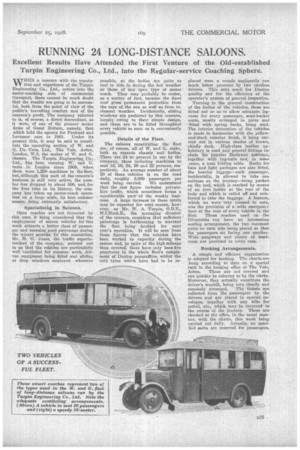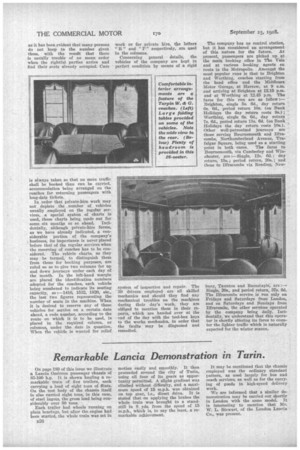RUNNING 24 LONG-DISTANCE SALOONS.
Page 9

Page 10

If you've noticed an error in this article please click here to report it so we can fix it.
Excellent Results Have Attended the First Venture of the Old-established Turpin Engineering Co., Ltd., into the Regular-service Coaching Sphere.
WHEN a concern with the reputation and experience of the Turpin Engineering Co., Ltd,, enters into the motor-coaching side of commercial transport, there cannot be much doubt that the results are going to be successful, both from the point of view of the public's travelling comfort and of the concern's profit. The company referred to is, of eourse, a direct descendant, as it were, of one of the pioneer motor firms of Great Britain, namely, that which held the agency for Panhard and Levassor ears in 1901. tinder its present title, it may be said to constitute the operating section of W. and G. Du Cros, Ltd., The Vale, Acton, London, W.3, the maker of W. and G. chassis. The Turpin Engineering Co., Ltd., has been running W. and G. taxis in London since 1909, when there were 1,250 machines in the fleet, but, although this part of the concern's business is still very active, the number has Aropped to about 500, and, for the first time in its history, the company has taken up motor-coach operation on a large scale, its first summer season being eminently satisfactory.
Specializing in Saloons.
Open coaches are not. favoured by this user, it being considered that the employment of saloon vehicles for this work attracts a better clasS of passenger and sustains goad patronage during the winter months. In this •connection, Mr. H. 0. Jones, the traffic superintendent of the company, pointed out to us that the vehicles are particularly well ventilated for summer work, Airvac equipment being fitted and sliding or drop windows employed wherever
possible, so the. bodies are quite as cool to ride in during the hot weather as those of any open type of motor coach. They may probably be cooler, as a matter of fact, because the fixed roof gives permanent protection from the rays of the sun as well as from inclement weather. Incidentally, sliding windows are preferred by this concern, largely owing to their simple design, and these are to be fitted throughout every vehicle as soon as is conveniently Possible.
Details of the Fleet.
The saloons constituting the fleet are. of course, all of W. and G. make, both as regards chassis and bodies. There are 24 at present in uSe by the company, these including machines to seat 16, 20, 24, 26 and 32 persona, respectively. An average number of about 20 of these vehicles is on the road daily, roughly 3,000 passengers per week being carried. We understand that the last figure includes privatehire traffic, which sometimes forms n considerable part of the weekly business. A large increase in these totals may be expected for next season, however, as Mr. W. A. Turpin, 0.B.E., M.I.Mech.E., the managing director of the concern, considers that sufficient patronage is forthcoming to warrant the fleet being doubled for next year's operation. It will be seett'from these figures that the vehicles have been worked to capacity during the season and, in spite of the high mileage thus covered, there have only been five punctures in the whole fleet's complement of Dunlop pneumetics, whilst the only tyres which have had to be re placed were a couple negligently run . much below pressure by two careless drivers. This says much for Dunlop quality and for the efficiency of the operator's system of general inspection.
Turning to the general construction of the bodies of the vehicles, these are fitted out so as to allow adequate legroom for every passenger, semi-bucket seats, mostly arranged in pairs and fitted with spring, backs, being used. The interior decoration of the vehicles is made to harmonize with the yellowand-black exterior finish, it being carried out in various shades of brown, chiefly dark. High-class leather upholstery is used and general fittings in,dude the 'Popular Beclawat ashtrays, together with rug-rails and, .in some eases, a neat folding table. Racks for hats and light packages are also fitted, the heavier luggage—each passenger, incidentally, is allowed to take one suitcase on the journey—being packed on the roof, which is reached by means of an iron ladder at the rear of the . body and which is railed off and reinforced to take the baggage. A feature, which we were very pleased to note, was the provision of a wide emergency door at the rear of every vehicle in the
fleet. Those coaches used on the Ilfracombe run have an interesting seating arrangement, the two rearmost pairs on each side being placed so thatthe passengers sit facing one another. Wide gangways and plenty of headroom are provided iu every case.
Booking Arrangements.
A simple and efficient organization is adopted for booking. The charts arehung according to date on a Special rack in the booking office at The Vale, Acton. These are not covered and can quickly be referred to by the clerks. Moreover, they actually constitute the driver's waybill, being very clearly and concisely arranged. T'he tickets are collected from the passengers by the drivers and are placed in special envelopes, together with any hula for petrol, etc., which may be incurred in the course of the journey. These are checked at the office, in the usual manner, with the charts, this work being carried out daily. Actually, no speci• fled seats are reserved for passengers, as it has been evident that many persons do not keep to the number given them, with the result that there is usually trouble of no mean order when the rightful parties arrive and End their seats already occupied. Care is always taken so that no more traffic shall be booked than can be carried, accommodation being arranged on the coaches for returning passengers with long-date tickets.
In order that private-hire work may not deplete the . number of vehicles usually employed on the regular services, a special system of charts is used, these charts being made out for some six months or so ahead. Incidentally, although private-hire forms, as we have already indicated, a considerable portion of the company's business, its importance is never placed before that of the regular services when the reserving of coaches has to be considered. The vehicle charts, as they may be termed, to distinguish them from those for booking purposes, are ruled so as to give two columns for up and down journeys under each day of the month. In the left-hand margin are placed the identification numbers adopted for the coaches, each vehicle being numbered to indicate its seating capacity, so :-1416, 1532, 1820, etc., the last two figures representing the number of seats in the machine. When it is desired to reserve any of these vehicles for service on a certain, date ahead, a code number, according to the route on which it is to be used, is placed in the required column, or columns, under -the date in question. "When the vehicle is svanted for relief
work or for private hire, the letters " R " and " P" respectively, are used in the columns.
Concerning general details, the vehicles of the company are kept in perfect condition by means of a rigid system of inspection and repair. The 30 drivers employed are all skilled mechanics and should they find any mechanical troubles on the machines during their day's work, they are obliged to mention them in their reports, which are handed over at the end of the day with the tool-box keys to the works mechanics, in order that the faults may be diagnosed and remedied.
The company has no control station, but it has considered an arrangement of this nature for the future. At present, passengers are picked up at the main booking office in The Vale and at various booking agents en route in the Metropolis. Amongst the most popular runs is that to Brighton and Worthing, coaches starting from the head office and the Middlesex Motor Garage, at Harrow, at 9 a.m. and arriving at Brighton at 12.15 p.m. and at Worthing at 12.45 p.m. The fares for this run are as follow :— Brighton, single 5s. (id., day return 6s. 6d., period return 10s. (on Bank Holidays the day return costs 9s.) ; Worthing, single 6s. 6d., day return ' 7s. 6d, period return 11s. 6d. (on Bank , Holidays the day return costs 1.0s.). Other well-patronized journeys are those serving Bournemouth and Ilfracombe, Northumberland Avenue, Trafalgar Square, being used as a starting
point in both cases. The fares to Bournemouth, via Camberley and Winchester, are :—Single, 12s. (Id.; day return, 15s.; period return, 20s.; and those to Ilfracombe via Reading, New bury, Taunton and Barnstaple, are :— Single, 20s., and period return, 37s. 6d. The Ilfracombe service is run only on Fridays and Saturdays from London, and on Saturdays and Sundays from Bfraeombe, the other services operated by the company being daily. Incidentally, we understand that this operator is shortly altering its fares to counter the lighter traffic which is naturally expected for the winter season.
































